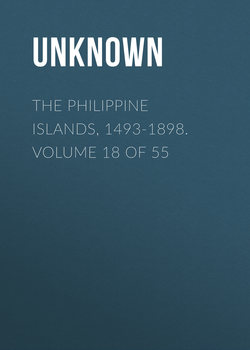Читать книгу The Philippine Islands, 1493-1898. Volume 18 of 55 - Unknown - Страница 6
На сайте Литреса книга снята с продажи.
Documents of 1617–1618
Description of the Philippinas Islands
ОглавлениеThe governmental district of the islands commonly called Philippinas comprises seven principal provinces, not to mention many other islands and smaller provinces within its jurisdiction. Five of these principal provinces are in the island of Luzon, which is four hundred and sixty leguas in periphery and extends about from the thirteenth to the twenty-first parallel. One can travel two hundred leguas in a straight line on this island, for it is even longer than this. From east to west, between the Cape of Spiritu Santo (the first sighted when coming from Nueba España) and the bay of Manila, it is eighty leguas; and from south to north, between the same bay and Cape Boseador, in the province of Cagayan, which is opposite Japon and China, it is one hundred and twenty leguas. The capital of Cagayan is the city of Nueba Segobia, which was settled by Governor Don Goncalo Ronquillo de Peñalosa in fifteen hundred and eighty-one. The shape of this island of Luzon, taken as a whole, is more like a semi-quadrant than anything else, although there are many irregularities in places. Some parts are narrow, because of the numerous arms of the sea which bound and penetrate the island; but in some parts, principally those on the north side, the island grows broader and more spacious, as I will show in the proper place. In other parts it is rough, rugged, and not a little mountainous. When the island is considered as shaped like a semi-quadrant, the great bay of Manila lies in the angle, where the sides meet the city—which is in the center of the island, near the entrance to the same bay; and has as a port Cavite, a little more than two leguas to the south.
Camarines
The first, of the five provinces in the island of Luzon, beginning on the eastern coast, is Camarines, which includes all the territory near the mouth of the channel of Capul. The capital of Camarines is the city of Cazeres, sixty leguas from Manila. It was settled by Doctor Francisco de Sande, governor of these islands, in fifteen hundred and seventy-four. He settled on the Vicor, a large and peaceful river, whose waters are very fresh and healthful, because it runs through many veins of gold, as do most or all of the rivers of these islands. There are in Camarines as many as twenty encomiendas, counting the four into which the island of Catanduanes (which is included in this district) is divided. The largest of these encomiendas does not contain more than fifteen hundred tributes; there are a few of one thousand; most of them must have from seven to eight hundred; while some have four hundred or even less. Among these peoples a great deal of gold was formerly obtained from the mines or placers of Paracali and from the island of Catanduanes. Camarines yields no rice, and it has not so good a food supply as other parts of Luzon, owing to the fact that Luzon is very narrow here, and in many places is rough and mountainous. It is believed that as much gold is mined now as usually, yet it seems a small quantity; for, although the Indians in general have more money than formerly, obtained through their [various] sources of income, they keep back the gold to work up into chains and jewelry, with which they adorn and parade themselves freely. They pay tribute in tin reals. The Camarines have become a very settled and tractable people through the religious instruction and careful teaching of the discalced Franciscan fathers, their ministers. They had been, of all the people of these islands, the most warlike and the most feared, as was shown by their resistance; indeed, one can hardly assert that they were conquered. The number of the inhabitants of this province can be but roughly estimated, as it is difficult to count them accurately. It is probable, however, that there are more than one hundred and fifty [thousand], counting the intractable black people who live in the interior of the country. Of this number some estimate that one-fourth are Christians.
